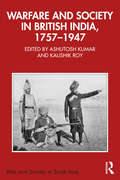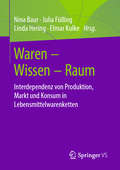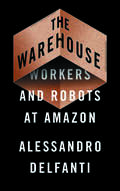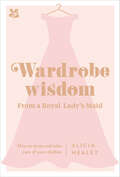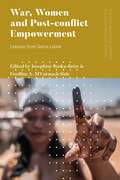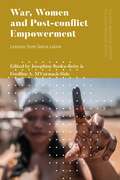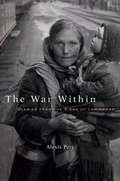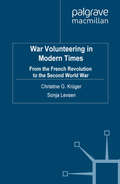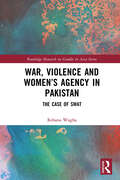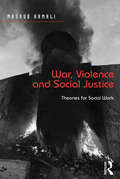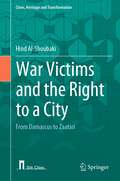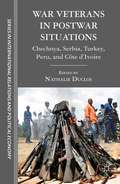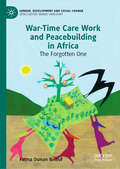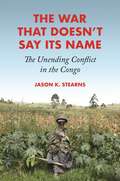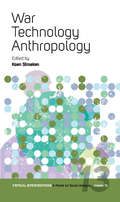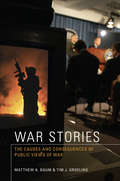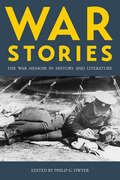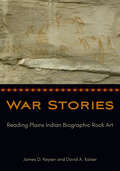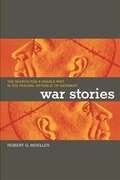- Table View
- List View
Warfare and Society in British India, 1757–1947 (War and Society in South Asia)
by Ashutosh Kumar Kaushik RoyThis book explores the intricate and intimate relationship between military organization, imperial policy, and society in colonial South Asia. The chapters in the volume focus on technology, logistics, and state building. The present volume highlights the salient features of expansion and consolidation of imperial control over the subcontinent, and ultimate demise of the Raj. Further, it turns the spotlight on to subaltern challenges to imperialism as well as the role of non-combatants in warfare. The volume: • Deals with both conventional and guerrilla conflicts and focuses on the frontiers (both North-West and North-East, including Burma); • Looks at the army as an institution rather than present a chronological account of military operations, which highlights the complex and tortuous relationship between combat institution, colonial state, and Indian society; • Integrates top-down approaches in military and strategic studies with the bottom-up perspectives and discusses on how the conduct of war (organisation and technology) is related to the economic, societal, and cultural impact of war. A rich account of the British ‘Army in India’, this book will be essential reading for scholars and researchers of South Asian history, military history, political history, colonialism, and the British Empire.
Waren – Wissen – Raum: Interdependenz von Produktion, Markt und Konsum in Lebensmittelwarenketten
by Nina Baur Julia Fülling Linda Hering Elmar KulkeDer Band betrachtet am Beispiel des Lebensmittelmarkts die drei Teilkontexte Produktion, Marktentnahme und Konsum in ihren wechselseitigen Handlungsbezügen sowie die Rolle von Macht und Wissen für die Koordination von Warenketten. Die Autorinnen und Autoren aus Geographie, Soziologie, Wirtschaftswissenschaften sowie der Stadt- und Regionalplanung widmen sich verschiedenen sich ergänzenden Aspekten der Koordination der Warenkette und der beteiligten Akteure von der Produktion, über die Logistik bis hin zum Handel und Konsum. Die Beiträge zeigen den unmittelbaren Zusammenhang zwischen Wissen und Handlungen der Akteure sowie deren Wirkungen auf die räumliche Organisation und Ordnung der Warenkette. Hinsichtlich der Rolle von Wissen geben die Beiträge eine Vielzahl an pointierten Analysen zu Teilaspekten der Gesamtinteraktionszusammenhänge.
The Warehouse: Workers and Robots at Amazon
by Alessandro Delfanti‘Work hard, have fun, make history’ proclaims the slogan on the walls of Amazon’s warehouses. This cheerful message hides a reality of digital surveillance, aggressive anti-union tactics and disciplinary layoffs. Reminiscent of the tumult of early industrial capitalism, the hundreds of thousands of workers who help Amazon fulfil consumers’ desire are part of an experiment in changing the way we all work. In this book, Alessandro Delfanti takes readers inside Amazon’s warehouses to show how technological advancements and managerial techniques subdue the workers rather than empower them, as seen in the sensors that track workers’ every movement around the floor and algorithmic systems that re-route orders to circumvent worker sabotage. He looks at new technologies including robotic arms trained by humans and augmented reality goggles, showing that their aim is to standardise, measure and discipline human work rather than replace it. Despite its innovation, Amazon will always need living labour’s flexibility and low cost. And as the warehouse is increasingly automated, worker discontent increases. Striking under the banner ‘we are not robots’, employees have shown that they are acutely aware of such contradictions. The only question remains: how long will it be until Amazon’s empire collapses?
The Warehouse: Workers and Robots at Amazon
by Alessandro Delfanti‘Work hard, have fun, make history’ proclaims the slogan on the walls of Amazon’s warehouses. This cheerful message hides a reality of digital surveillance, aggressive anti-union tactics and disciplinary layoffs. Reminiscent of the tumult of early industrial capitalism, the hundreds of thousands of workers who help Amazon fulfil consumers’ desire are part of an experiment in changing the way we all work. In this book, Alessandro Delfanti takes readers inside Amazon’s warehouses to show how technological advancements and managerial techniques subdue the workers rather than empower them, as seen in the sensors that track workers’ every movement around the floor and algorithmic systems that re-route orders to circumvent worker sabotage. He looks at new technologies including robotic arms trained by humans and augmented reality goggles, showing that their aim is to standardise, measure and discipline human work rather than replace it. Despite its innovation, Amazon will always need living labour’s flexibility and low cost. And as the warehouse is increasingly automated, worker discontent increases. Striking under the banner ‘we are not robots’, employees have shown that they are acutely aware of such contradictions. The only question remains: how long will it be until Amazon’s empire collapses?
Wardrobe Wisdom: How To Dress And Take Care Of Your Clothes
by Alicia Healey National Trust BooksYou and your clothes can always look their fabulous best with the wisdom of Alicia Healey, a lady's maid and wardrobe consultant who trained at Buckingham Palace and now works with clients around the world. She knows what works for you and what fits every occasion.
War, Women and Post-conflict Empowerment: Lessons from Sierra Leone (Politics and Development in Contemporary Africa)
by Josephine Beoku-Betts Fredline A. M'Cormack-HaleSince the 1991-2002 civil conflict ended in Sierra Leone, the country has failed to translate the accomplishments of women's involvement in bringing the war to an end into meaningful political empowerment. This is in marked contrast to other post-conflict countries, which have increased the political participation of women in elected and appointed office, increased the representation of women in leadership positions, and enacted constitutional reforms promoting women's rights.Written by Sierra Leonean and Africanist scholars and experts from a broad range of disciplines, this unique volume analyses the historical and contextual factors influencing women's political, economic and social development in the country. In drawing on a diverse array of case studies – from health to education, refugees to international donors – the contradictions, successes and challenges of women's lives in a post-conflict environment are revealed, making this an essential book for anyone involved in women and development.
War, Women and Post-conflict Empowerment: Lessons from Sierra Leone (Politics and Development in Contemporary Africa)
by Josephine Beoku-Betts Fredline A. M’Cormack-HaleSince the 1991-2002 civil conflict ended in Sierra Leone, the country has failed to translate the accomplishments of women's involvement in bringing the war to an end into meaningful political empowerment. This is in marked contrast to other post-conflict countries, which have increased the political participation of women in elected and appointed office, increased the representation of women in leadership positions, and enacted constitutional reforms promoting women's rights.Written by Sierra Leonean and Africanist scholars and experts from a broad range of disciplines, this unique volume analyses the historical and contextual factors influencing women's political, economic and social development in the country. In drawing on a diverse array of case studies – from health to education, refugees to international donors – the contradictions, successes and challenges of women's lives in a post-conflict environment are revealed, making this an essential book for anyone involved in women and development.
The War Within: Diaries From The Siege Of Leningrad
by Alexis PeriThe German blockade of Leningrad lasted 872 days and cost almost a million civilian lives—one of the longest, deadliest sieges in modern history. Drawing on 125 unpublished diaries written by individuals from all walks of life, Alexis Peri tells the tragic, intimate story of how citizens struggled to make sense of a world collapsing around them.
The War Within: Diaries From The Siege Of Leningrad
by Alexis PeriThe German blockade of Leningrad lasted 872 days and cost almost a million civilian lives—one of the longest, deadliest sieges in modern history. Drawing on 125 unpublished diaries written by individuals from all walks of life, Alexis Peri tells the tragic, intimate story of how citizens struggled to make sense of a world collapsing around them.
War Volunteering in Modern Times: From the French Revolution to the Second World War
by Christine G. Krüger & Sonja LevsenExploring volunteering as a characteristic of modern wars, this book examines why individuals go to war. It studies the motivations, social backgrounds and military experiences of war volunteers in a wide range of conflicts since the French Revolution, and helps to interpret the relationship between war and society in modern times.
War, Violence and Women’s Agency in Pakistan: The Case of Swat (Routledge Research on Gender in Asia Series)
by Rehana WaghaWar, Violence and Women’s Agency in Pakistan investigates the prominent features of gender ideology in the Swat region, Pakistan and how they influence the norms and forms of women’s agency during conflict.After 9/11, the War on Terror brought a new wave of anarchy, extremism and violence to the valley of Swat. This book investigates the socio-political structures in the region and examines their impact on women’s political behaviour. The author asks how these patriarchal socio-political structures have contributed to the formation of women’s subjectivities and their ability to subvert and resist patriarchal regimes of oppression. She examines how women experienced militancy, what led them to support or resist the Taliban and how they coped with everyday violence, displacement and resettlement in the period from 2005 to 2010. Multidisciplinary in its approach, the book analyses the norms and forms of women’s agency under the postmodern structure and agency framework of feminist political theory, which views structure and agency as co-constituted and mutually dependent.Focusing on women’s narratives and the norms and forms of their behaviour from a woman’s perspective, this book is a welcome addition to the analysis of the violence in the Swat region, Pakistan. It will be of interest to scholars of Gender Studies, War and Conflict Studies and South Asian Studies.
War, Violence and Women’s Agency in Pakistan: The Case of Swat (Routledge Research on Gender in Asia Series)
by Rehana WaghaWar, Violence and Women’s Agency in Pakistan investigates the prominent features of gender ideology in the Swat region, Pakistan and how they influence the norms and forms of women’s agency during conflict.After 9/11, the War on Terror brought a new wave of anarchy, extremism and violence to the valley of Swat. This book investigates the socio-political structures in the region and examines their impact on women’s political behaviour. The author asks how these patriarchal socio-political structures have contributed to the formation of women’s subjectivities and their ability to subvert and resist patriarchal regimes of oppression. She examines how women experienced militancy, what led them to support or resist the Taliban and how they coped with everyday violence, displacement and resettlement in the period from 2005 to 2010. Multidisciplinary in its approach, the book analyses the norms and forms of women’s agency under the postmodern structure and agency framework of feminist political theory, which views structure and agency as co-constituted and mutually dependent.Focusing on women’s narratives and the norms and forms of their behaviour from a woman’s perspective, this book is a welcome addition to the analysis of the violence in the Swat region, Pakistan. It will be of interest to scholars of Gender Studies, War and Conflict Studies and South Asian Studies.
War, Violence and Social Justice: Theories for Social Work
by Masoud KamaliThis book analyses the role of war and violence (in both its physical and symbolic forms) for social work in a time of neoliberal globalisation from a social justice perspective. It argues that the consequences of wars, in both their old and new forms, and the exercise of symbolic violence for the practices of social work at national and global levels have been ignored. This work explores the relationship between recent neoliberal and global transformations and their consequences for intensifying ’new wars’ and conflicts in non-Western countries on the one hand, and the increasing symbolic violence against marginalised people with immigrant and non-Western background in many Western countries, on the other. The analytical approach of the book, based on the theories of multiple modernities and symbolic violence, is unique since no other work has applied such theoretical perspectives for analysing inequalities in relation to the condition of lives of non-Western people living in Western and non-Western countries. This is a necessary contribution for social work education and research since the discipline needs new theoretical perspectives to be able to meet the new challenges raised by recent global transformations and neoliberal globalisation.
War, Violence and Social Justice: Theories for Social Work
by Masoud KamaliThis book analyses the role of war and violence (in both its physical and symbolic forms) for social work in a time of neoliberal globalisation from a social justice perspective. It argues that the consequences of wars, in both their old and new forms, and the exercise of symbolic violence for the practices of social work at national and global levels have been ignored. This work explores the relationship between recent neoliberal and global transformations and their consequences for intensifying ’new wars’ and conflicts in non-Western countries on the one hand, and the increasing symbolic violence against marginalised people with immigrant and non-Western background in many Western countries, on the other. The analytical approach of the book, based on the theories of multiple modernities and symbolic violence, is unique since no other work has applied such theoretical perspectives for analysing inequalities in relation to the condition of lives of non-Western people living in Western and non-Western countries. This is a necessary contribution for social work education and research since the discipline needs new theoretical perspectives to be able to meet the new challenges raised by recent global transformations and neoliberal globalisation.
War Victims and the Right to a City: From Damascus to Zaatari (Cities, Heritage and Transformation)
by Hind Al-ShoubakiThis book analyzes the role of integrated spatial planning in constructing eco-sustainable urban housing in post-conflict scenarios and investigates two different spaces in an emergency: Zaatari refugee camp in Jordan and Damascus city in Syria. The book presents a new innovative tool that assists in building a successful and sustainable reconstruction after emergencies which corresponds to the planning approach's heterogeneous nature within emergency situations. The same innovative theoretical framework also covers the ramifications of climate change on the urban built environment and reduces its sociological impact on the stricken communities.This book is intended for researchers, academics, students, spatial planners, policy makers, think tank groups, and public entities who are interested in post-disaster reconstruction and the issues of refugee camps.
War Veterans in Postwar Situations: Chechnya, Serbia, Turkey, Peru, and Côte d’Ivoire (The Sciences Po Series in International Relations and Political Economy)
by Nathalie DuclosThis edited volume deals with the reintegration and trajectories of intrastate or interstate war veterans. It raises the question of the effects of the war experience on ex-combatants with regards, in particular, to the perpetuation of a certain level of violence as well as the maintaining of structures, networks, and war methods after the war.
War-Time Care Work and Peacebuilding in Africa: The Forgotten One (Gender, Development and Social Change)
by Fatma Osman IbnoufThis book provides a nuanced understanding of an often neglected aspect of armed conflicts, namely the everyday structures that sustain lives during crises and, specifically, care-work performed by women. It showcases the work of women as key protagonists and stresses their role as knowledge producers in studies of conflict. The author brings an original voice to the literature on women in conflict and peace-building showing the unpaid and less visible care-work that women do in the context of conflict and post-conflict and peacebuilding in Africa.
The War That Doesn't Say Its Name: The Unending Conflict in the Congo
by Jason K. StearnsWhy violence in the Congo has continued despite decades of international intervention Well into its third decade, the military conflict in the Democratic Republic of the Congo has been dubbed a “forever war”—a perpetual cycle of war, civil unrest, and local feuds over power and identity. Millions have died in one of the worst humanitarian calamities of our time. The War That Doesn’t Say Its Name investigates the most recent phase of this conflict, asking why the peace deal of 2003—accompanied by the largest United Nations peacekeeping mission in the world and tens of billions in international aid—has failed to stop the violence. Jason Stearns argues that the fighting has become an end in itself, carried forward in substantial part through the apathy and complicity of local and international actors.Stearns shows that regardless of the suffering, there has emerged a narrow military bourgeoisie of commanders and politicians for whom the conflict is a source of survival, dignity, and profit. Foreign donors provide food and urgent health care for millions, preventing the Congolese state from collapsing, but this involvement has not yielded transformational change. Stearns gives a detailed historical account of this period, focusing on the main players—Congolese and Rwandan states and the main armed groups. He extrapolates from these dynamics to other conflicts across Africa and presents a theory of conflict that highlights the interests of the belligerents and the social structures from which they arise.Exploring how violence in the Congo has become preoccupied with its own reproduction, The War That Doesn't Say Its Name sheds light on why certain military feuds persist without resolution.
The War That Doesn't Say Its Name: The Unending Conflict in the Congo
by Jason K. StearnsWhy violence in the Congo has continued despite decades of international intervention Well into its third decade, the military conflict in the Democratic Republic of the Congo has been dubbed a “forever war”—a perpetual cycle of war, civil unrest, and local feuds over power and identity. Millions have died in one of the worst humanitarian calamities of our time. The War That Doesn’t Say Its Name investigates the most recent phase of this conflict, asking why the peace deal of 2003—accompanied by the largest United Nations peacekeeping mission in the world and tens of billions in international aid—has failed to stop the violence. Jason Stearns argues that the fighting has become an end in itself, carried forward in substantial part through the apathy and complicity of local and international actors.Stearns shows that regardless of the suffering, there has emerged a narrow military bourgeoisie of commanders and politicians for whom the conflict is a source of survival, dignity, and profit. Foreign donors provide food and urgent health care for millions, preventing the Congolese state from collapsing, but this involvement has not yielded transformational change. Stearns gives a detailed historical account of this period, focusing on the main players—Congolese and Rwandan states and the main armed groups. He extrapolates from these dynamics to other conflicts across Africa and presents a theory of conflict that highlights the interests of the belligerents and the social structures from which they arise.Exploring how violence in the Congo has become preoccupied with its own reproduction, The War That Doesn't Say Its Name sheds light on why certain military feuds persist without resolution.
War, Technology, Anthropology (Critical Interventions: A Forum for Social Analysis #13)
by Koen StroekenTechnologies of the allied warfare in Iraq and Afghanistan, such as remote-controlled drones and night vision goggles, allow the user to “virtualize” human targets. This coincides with increased civilian casualties and a perpetuation of the very insecurity these technologies are meant to combat. This concise volume of research and reflections from different regions across Asia, the Middle East, Latin America, and Africa, observes how anthropology operates as a technology of war. It tackles recent theories of humans in society colluding with imperialist claims, including anthropologists who have become involved professionally in warfare through their knowledge of “cultures,” renamed as “human terrain systems.” The chapters link varied yet crucial domains of inquiry: from battlefields technologies, military-driven scientific policy, and economic warfare, to martyrdom cosmology shifts, media coverage of “distant” wars, and the virtualizing techniques and “war porn” soundtracks of the gaming industry.
War Stories: The Causes and Consequences of Public Views of War
by Matthew A. Baum Tim J. GroelingHow does the American public formulate its opinions about U.S. foreign policy and military engagement abroad? War Stories argues that the media systematically distort the information the public vitally needs to determine whether to support such initiatives, for reasons having more to do with journalists' professional interests than the merits of the policies, and that this has significant consequences for national security. Matthew Baum and Tim Groeling develop a "strategic bias" theory that explains the foreign-policy communication process as a three-way interaction among the press, political elites, and the public, each of which has distinct interests, biases, and incentives. Do media representations affect public support for the president and faithfully reflect events in times of diplomatic crisis and war? How do new media--especially Internet news and more partisan outlets--shape public opinion, and how will they alter future conflicts? In answering such questions, Baum and Groeling take an in-depth look at media coverage, elite rhetoric, and public opinion during the Iraq war and other U.S. conflicts abroad. They trace how traditional and new media select stories, how elites frame and sometimes even distort events, and how these dynamics shape public opinion over the course of a conflict. Most of us learn virtually everything we know about foreign policy from media reporting of elite opinions. In War Stories, Baum and Groeling reveal precisely what this means for the future of American foreign policy.
War Stories: The War Memoir in History and Literature
by Philip DwyerAlthough war memoirs constitute a rich, varied literary form, they are often dismissed by historians as unreliable. This collection of essays is one of the first to explore the modern war memoir, revealing the genre’s surprising capacity for breadth and sophistication while remaining sensitive to the challenges it poses for scholars. Covering conflicts from the Napoleonic era to today, the studies gathered here consider how memoirs have been used to transmit particular views of war even as they have emerged within specific social and political contexts.
War Stories: Reading Plains Indian Biographic Rock Art
by David Kaiser James D. KeyserPlains Indian biographic rock art can be “read” by those knowledgeable in its lexicon. Presented is a lexicon of imagery, conventions, and symbols used by Plains Indians to communicate their warfare and social narratives. The reader is introduced to Plains Indian “warrior” art in all media, biographic art as picture writing is explained, and the lexicon is described, providing a pictographic “dictionary,” and explains conventions and connotations. Finally, it illustrates four key examples of how these narratives are read by the observer. Familiarity with the lexicon will enable interested scholars and laypersons to understand what are otherwise enigmatic rock art drawings found from Calgary, Alberta through ten U.S. states, and into the Mexican state of Coahuila.
War Stories: Reading Plains Indian Biographic Rock Art
by James D. Keyser David KaiserPlains Indian biographic rock art can be “read” by those knowledgeable in its lexicon. Presented is a lexicon of imagery, conventions, and symbols used by Plains Indians to communicate their warfare and social narratives. The reader is introduced to Plains Indian “warrior” art in all media, biographic art as picture writing is explained, and the lexicon is described, providing a pictographic “dictionary,” and explains conventions and connotations. Finally, it illustrates four key examples of how these narratives are read by the observer. Familiarity with the lexicon will enable interested scholars and laypersons to understand what are otherwise enigmatic rock art drawings found from Calgary, Alberta through ten U.S. states, and into the Mexican state of Coahuila.
War Stories: The Search For A Usable Past In The Federal Republic Of Germany
by Robert G. MoellerThis book discusses the ways in which Germany created a public memory of World War II that established the war's most tragic victims to be not the Jews and other victims of National Socialism, but the Germans themselves.
